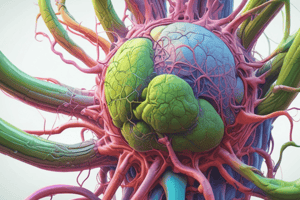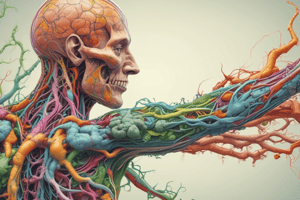Podcast
Questions and Answers
Which stage of Hodgkin's lymphoma indicates involvement of lymph node regions on both sides of the diaphragm?
Which stage of Hodgkin's lymphoma indicates involvement of lymph node regions on both sides of the diaphragm?
- Stage 3 (correct)
- Stage 4
- Stage 1
- Stage 2
What is a key cellular characteristic that differentiates Hodgkin's lymphoma from Non-Hodgkin's lymphoma?
What is a key cellular characteristic that differentiates Hodgkin's lymphoma from Non-Hodgkin's lymphoma?
- Exact linear pattern of spread
- Lack of plasma cell involvement
- Absence of lymphatic blockage
- Presence of Reed-Sternberg cells (correct)
What is typically a prognosis range for Multiple Myeloma?
What is typically a prognosis range for Multiple Myeloma?
- 3 to 5 years (correct)
- 10 years or more
- 5 to 10 years
- 1 to 2 years
What is a common cause of lymphedema?
What is a common cause of lymphedema?
What distinguishes Non-Hodgkin's lymphoma in terms of its spread compared to Hodgkin's lymphoma?
What distinguishes Non-Hodgkin's lymphoma in terms of its spread compared to Hodgkin's lymphoma?
Which symptom is commonly associated with Multiple Myeloma?
Which symptom is commonly associated with Multiple Myeloma?
In managing lymphedema, which of the following is NOT a recommended method?
In managing lymphedema, which of the following is NOT a recommended method?
What is Castleman's Disease primarily characterized by?
What is Castleman's Disease primarily characterized by?
What is the primary function of lymphatic vessels?
What is the primary function of lymphatic vessels?
Where do T lymphocytes mature?
Where do T lymphocytes mature?
Which type of lymphoma is characterized by the presence of Reed-Sternberg cells?
Which type of lymphoma is characterized by the presence of Reed-Sternberg cells?
What is the role of lymph nodes in the lymphatic system?
What is the role of lymph nodes in the lymphatic system?
What are systemic signs of lymphoma?
What are systemic signs of lymphoma?
Which two regions drain lymph into different subclavian veins?
Which two regions drain lymph into different subclavian veins?
What is the role of the spleen in the lymphatic system?
What is the role of the spleen in the lymphatic system?
What type of tissue is GALT associated with?
What type of tissue is GALT associated with?
Flashcards
Stage 3 Hodgkin's Lymphoma
Stage 3 Hodgkin's Lymphoma
Involvement of lymph node regions on both sides of the diaphragm.
Stage 4 Hodgkin's Lymphoma
Stage 4 Hodgkin's Lymphoma
Spread to organs, typically the spleen and liver.
Multiple Myeloma
Multiple Myeloma
A cancer affecting plasma cells, which are B lymphocytes.
Lymphedema
Lymphedema
Signup and view all the flashcards
Castleman's Disease
Castleman's Disease
Signup and view all the flashcards
Stage 1 Hodgkin's Lymphoma
Stage 1 Hodgkin's Lymphoma
Signup and view all the flashcards
Stage 2 Hodgkin's Lymphoma
Stage 2 Hodgkin's Lymphoma
Signup and view all the flashcards
Reed-Sternberg Cells
Reed-Sternberg Cells
Signup and view all the flashcards
What is the lymphatic system?
What is the lymphatic system?
Signup and view all the flashcards
What is lymph?
What is lymph?
Signup and view all the flashcards
What are lymph nodes?
What are lymph nodes?
Signup and view all the flashcards
What is lymphoma?
What is lymphoma?
Signup and view all the flashcards
What is Hodgkin's Lymphoma?
What is Hodgkin's Lymphoma?
Signup and view all the flashcards
What is Non-Hodgkin's Lymphoma?
What is Non-Hodgkin's Lymphoma?
Signup and view all the flashcards
What is the spleen's key function in the lymphatic system?
What is the spleen's key function in the lymphatic system?
Signup and view all the flashcards
What are MALT (mucosa-associated lymphoid tissue) and GALT (gut-associated lymphoid tissue) in the immune system?
What are MALT (mucosa-associated lymphoid tissue) and GALT (gut-associated lymphoid tissue) in the immune system?
Signup and view all the flashcards
Study Notes
The Lymphatic System
- The lymphatic system is a vital part of the body's immune defense, working alongside the cardiovascular system.
- It encompasses lymphatic vessels, lymph nodes, tonsils, spleen, thymus, and bone marrow.
- Lymphatic vessels collect and filter interstitial fluid before returning it to the bloodstream.
- This process removes excess fluid and cellular debris, especially during inflammation and edema.
- Lymph nodes serve as filters for lymph, removing pathogens and cellular debris.
- Lymph primarily drains into the left subclavian vein; the right arm, chest, and cervical region drain into the right subclavian vein.
- Tonsils are lymphoid tissues in the throat, providing immunity against pathogens entering via the mouth or nose.
- The spleen filters blood, destroys old red blood cells, and stores white blood cells for immune response.
- Red bone marrow produces various blood cells, including lymphocytes.
- B lymphocytes mature in the bone marrow, while T lymphocytes mature in the thymus.
- The lymphatic system absorbs lipids from the gastrointestinal tract.
- Gut-associated lymphoid tissue (GALT) and mucosa-associated lymphoid tissue (MALT) line areas exposed to the external environment offering crucial immune protection.
Lymphoma
- Lymphoma is a cancer of lymph nodes, characterized by a malignant neoplasm.
- It broadly categorizes into Hodgkin's lymphoma and non-Hodgkin's lymphoma.
- Hodgkin's lymphoma typically starts with a painless, enlarged lymph node.
- This painless swelling is a crucial sign that warrants prompt evaluation.
- Hodgkin's lymphoma features Reed-Sternberg cells (two-lobed nucleus) in the affected lymph nodes.
- The cancer predictably spreads through lymph nodes and may involve the spleen.
- Systemic signs include weight loss, anemia, low-grade fever, night sweats, and persistent fatigue.
- Management often involves surgery, chemotherapy, and radiation therapy.
- Hodgkin's lymphoma stages 1-4 are determined by the number and location of affected lymph nodes.
Hodgkin's Lymphoma Stages
- Hodgkin's lymphoma starts with a single enlarged lymph node.
- Stage 1: Involvement of a single lymph node region.
- Stage 2: Involvement of multiple lymph node regions on the same side of the diaphragm.
- Stage 3: Involvement of lymph node regions on both sides of the diaphragm.
- Stage 4: Spread to organs, typically the spleen and liver.
Non-Hodgkin's Lymphoma
- Non-Hodgkin's lymphoma, unlike Hodgkin's, has unpredictable spread patterns.
- It lacks Reed-Sternberg cells, making it distinguishable from Hodgkin's lymphoma.
Multiple Myeloma
- Multiple myeloma is a bone marrow cancer impacting plasma cells (a type of B lymphocyte).
- It's characterized by deep bone pain and lytic lesions (appearing as "moth-eaten" areas on X-rays).
- Multiple myeloma typically carries a poor prognosis, typically 3-5 years.
- Metastasis is common, worsening the prognosis.
- Impaired kidney function can emerge due to plasma cell-related substances accumulating in the blood and potentially leading to chronic kidney failure.
Lymphedema
- Lymphedema results from lymphatic vessel blockage.
- Causes encompass tumors, radiation therapy scarring, or lymph node removal surgery.
- Swelling, particularly in the limb distal to the blockage, is a common characteristic.
- Management involves diuretics, compression garments, elevation, lymphatic drainage massage, and avoiding trauma to the affected limb.
- Elephantiasis (filariasis) is a severe lymphedema form caused by parasitic infection.
Castleman's Disease
- Castleman's disease involves non-cancerous lymphoid tissue overgrowth, especially in lymph nodes.
- It's characterized by enlargement of one or more lymph nodes.
- It is not considered a neoplastic disease.
Studying That Suits You
Use AI to generate personalized quizzes and flashcards to suit your learning preferences.




